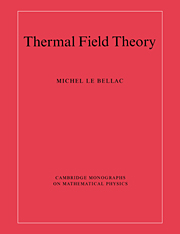Book contents
- Frontmatter
- Contents
- Preface
- 1 Introduction
- 2 Quantum statistical mechanics
- 3 The scalar field at finite temperature
- 4 Simple applications of perturbation theory
- 5 Dirac and gauge fields at finite temperature
- 6 Collective excitations in a plasma
- 7 Hard thermal loops and resummation
- 8 Dynamical screening
- 9 Neutrino emission from stars
- 10 Infrared problems at finite temperature
- A Formulary
- B Operator formalism
- References
- Index
9 - Neutrino emission from stars
Published online by Cambridge University Press: 05 May 2010
- Frontmatter
- Contents
- Preface
- 1 Introduction
- 2 Quantum statistical mechanics
- 3 The scalar field at finite temperature
- 4 Simple applications of perturbation theory
- 5 Dirac and gauge fields at finite temperature
- 6 Collective excitations in a plasma
- 7 Hard thermal loops and resummation
- 8 Dynamical screening
- 9 Neutrino emission from stars
- 10 Infrared problems at finite temperature
- A Formulary
- B Operator formalism
- References
- Index
Summary
There are some interesting applications of thermal field theory to astro-physical processes; to be fair, all necessary computations may also be performed in the framework of standard kinetic theory, but experience with thermal field theory has recently allowed us to improve earlier calculations, resulting in large corrections in some circumstances. We shall be interested in the energy losses of stars due to the emission of weakly interacting particles. The relevant astrophysical systems are the following.
(i) The core of type II supernovae, which is a plasma with temperature T ∼ 30–60 MeV and density π ∼ 1015 g cm−3. The electron chemical potential is µ ∼ 350 MeV and the plasma frequency is ωp ∼ 20 MeV.
(ii) The core of red giants before the ‘helium flash’: in this case T ∼ 108 K (10 keV), π ≃ 106 g cm−3, corresponding to an almost degenerate electron gas with Fermi momentum PF ≃ 400 keV/c and a plasma frequency ωp ≃ 20 keV.
(iii) The core of young white dwarves, in which typical conditions are T ∼ 106 − 107 K (0.1–1 keV) and π ≃ 2 × 106 g cm−3, which again corresponds to an almost degenerate electron gas with Fermi momentum PF ≃ 500 keV.
- Type
- Chapter
- Information
- Thermal Field Theory , pp. 212 - 221Publisher: Cambridge University PressPrint publication year: 1996



